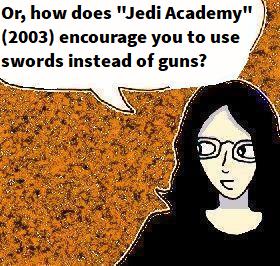
Well, since I couldn’t think of a better idea for an article, I thought that I’d talk about a clever design decision in the old computer game that I was playing at the time of writing. I am, of course, talking about the 2003 sci-fi action game “Star Wars: Jedi Knight: Jedi Academy”.
One of the interesting things about this game is how – through game design alone – it encourages you to use the Star Wars series’ iconic lightsaber (a glowing laser sword) instead of other weapons.
Whilst it is the very first weapon you are given – during the introductory level – the designers clearly wanted to avoid turning it into a typical videogame starting weapon which usually gets completely ignored after a couple of levels.
Not only is it the most famous sci-fi weapon ever created, but there was also clearly a lot of effort put into animating attacks for it and other cool features – such as the ability to learn/change fighting styles, to throw it like a boomerang, to customise its appearance at the very beginning of the game etc… – to the point it just feels seriously cool to use. Not to mention that it is also part of the “special sauce” which makes the Star Wars franchise so unique.
After all, “Star Wars” was one of the first major media franchises to blend both the sci-fi and fantasy genres in an innovative way. The series famously takes place “A long time ago, in a galaxy far far away“, allowing for both the historical-style theme of a fantasy story but with enough leeway for lots of spaceships, planets, lasers, robots etc… too. A major part of this mixture of genres is that one of the main groups of characters – the Jedi Knights – uses magic and swords… sorry, “The Force” and lightsabers.
With the exception of the introductory level and the tutorial level, where you can only use the lightsaber, the other levels in “Jedi Academy” (2003) let you choose two futuristic guns before you start each level. In the real world, guns are more powerful weapons than swords. So, as soon as the player gets one, then they will intuitively use it instead. And, given how laser guns are also an important part of the series, the designers couldn’t just not include any guns in the game.
Not only that, when you switch to one of the guns, the game’s perspective changes and it becomes a first-person shooter game. Given how – even back in 2003 – a typical player would already be very familiar with this style of gameplay, there was a real risk that players could quickly end up neglecting the game’s coolest weapon – especially given its limited range. So, how did the designers prevent this?
Simply put, they used weapon balancing and level design. Until at least a third to half of the way through the game, the ranged weapons are noticeably weaker than the lightsaber. However, many early-game enemies will fall with just a single swing of your lightsaber – encouraging you to run towards them and use that instead.
It isn’t even until about two-thirds of the way through the game that you get a weapon – the “Stouker Concussion Rifle” – that is considerably more powerful than the lightsaber. And, by that point, you’ll already be used to reflexively drawing your lightsaber whenever there is trouble.
Likewise, whilst the game certainly does include wide-open levels, there is also a heavy emphasis on claustrophobic corridors, smaller rooms and places where it is more intuitive for the player to fight at close range. Again, this is also there to encourage the player to switch to their lightsaber rather than trying to fight from a distance with a – less powerful – laser gun.
Also, especially during the later parts of the game, there are sometimes lightsaber-wielding villains who can only be fought using lightsabers (and “force powers” – magic spells). If you try to use a projectile weapon against them, they will literally just deflect the projectile right back at you. Yes, these lightsaber duels aren’t really the most well-designed part of the game’s combat, but it’s still a clever way to ensure that the player still uses this weapon even very late into the game.
But, yes, something as simple as weapon balancing, enemy design and level design can be used to shape how the player plays the game. Again, whilst the lightsaber looks/sounds cool, you’ll probably still instinctively switch to a laser gun as soon as you get one… only to quickly switch back to the lightsaber when you realise that the gun isn’t as powerful as you thought it would be. It’s subtle, but excellent, game design 🙂
—————-
Anyway, I hope that this was interesting 🙂









